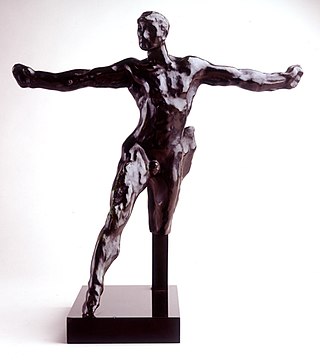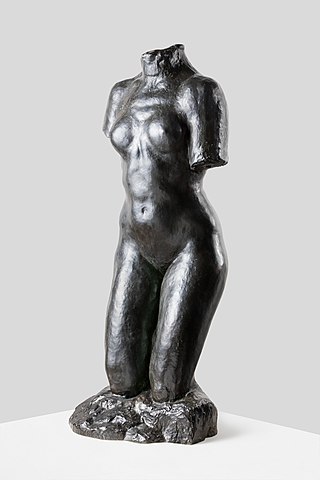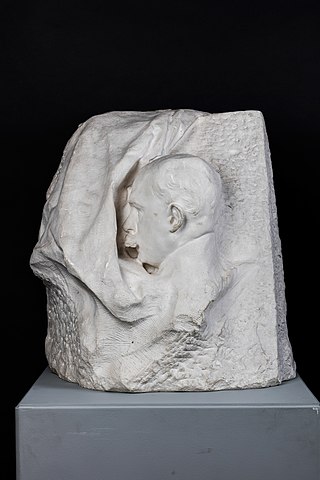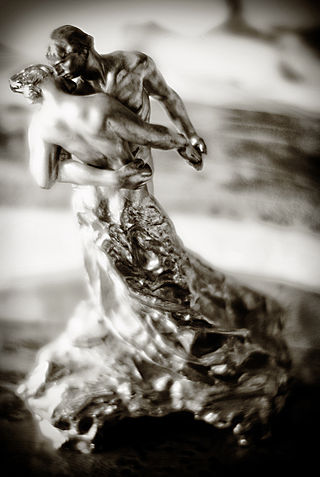
Camille Rosalie Claudel was a French sculptor known for her figurative works in bronze and marble. She died in relative obscurity, but later gained recognition for the originality and quality of her work. The subject of several biographies and films, Claudel is well known for her sculptures including The Waltz and The Mature Age.

Alfred Boucher was a French sculptor who was a mentor to Camille Claudel and a friend of Auguste Rodin.

Perseus and the Gorgon is a 1902 monumental sculpture by Camille Claudel that portrays a scene from Greek mythology. The artist sculpted her own likeness for Medusa's face, in anger after the break-up of her romantic partnership with sculptor Auguste Rodin. The work achieved a great notoriety throughout the years.

The Museo Soumaya is a private museum in Mexico City and a non-profit cultural institution with two museum buildings in Mexico City — Plaza Carso and Plaza Loreto. It has over 66,000 works from 30 centuries of art including sculptures from Pre-Hispanic Mesoamerica, 19th- and 20th-century Mexican art and an extensive repertoire of works by European old masters and masters of modern western art such as Auguste Rodin, Salvador Dalí, Bartolomé Esteban Murillo and Tintoretto. It is called one of the most complete collections of its kind.

Eternal Springtime is a c. 1884 sculpture by the French artist Auguste Rodin, depicting a pair of lovers. It was created at the same time as The Gates of Hell and originally intended to be part of it. One of its rare 19th-century original casts belongs to the permanent collection of Calouste Gulbenkian Museum.

Head of Saint John the Baptist is a marble sculpture by French artist Auguste Rodin, sculpted in 1887 as part of a series of sculptures based on his Saint John the Baptist, exhibited for the first time in 1880 with great acceptance and recognition from critics.

Standing Mercury is a bronze sculpture by French artist Auguste Rodin, first exhibited in 1888. Rodin depicts the mythological god Mercury, son of Maia and Jupiter—messenger of the gods and guide to the Underworld—as a young man, representing eloquence and reason. This depiction is opposite to the traditional representation of Hermes, its Greek counterpart, as a mature man.

The Three Shades is a sculptural group produced in plaster by Auguste Rodin in 1886 for his The Gates of Hell. He made several individual studies for the Shades before finally deciding to put them together as three identical figures gathered around a central point. The heads hang low so that the neck and shoulders form an almost-horizontal plane. They were to be placed above the gates looking down on the viewer.

The Maiden Kissed by the Ghost is an 1880 sculpture by the French artist Auguste Rodin. It was first exhibited at his fourteenth exhibition, hosted by the National Society Salon. One of the marble versions of the work is now in the Museo Soumaya in Mexico City.

The Kneeling Man is a work originally conceived in 1888 by the French artist Auguste Rodin for his The Gates of Hell project.

The Succubus is a bronze sculpture with a green and dark brown patina. It was originally conceived in 1889 by the French artist Auguste Rodin as part of a set of works showing sirens and Nereids. It later formed part of his state-commissioned monument to Victor Hugo. It is now in the Museo Soumaya in Mexico City.

Eustache de Saint Pierre is a sculpture by Auguste Rodin, now in the Museo Soumaya in Mexico City. It was conceived between 1885 and 1886 as part of his The Burghers of Calais group. The other figures in the group were also cast as individual figures.

Glaucus is a sculpture by the French artist Auguste Rodin, first conceived in 1886 as a representation of the mythological figure Glaucus, son of Poseidon. Originally made in plaster, bronze casts of it are now in the Brooklyn Museum and the Museo Soumaya.

Young Mother is a bronze sculpture by Auguste Rodin with a brown and green patina, conceived in 1885 and cast by the Rudier Foundry.

The Prayer is a 1909 sculpture by Auguste Rodin. As in his The Walking Man, he explores a fragment of a figure.

Ovid's Metamorphoses or The Satyrs is a sculpture by Auguste Rodin, created as part of The Gates of Hell.

Octave Mirbeau is an 1895 plaster relief by Auguste Rodin of the writer Octave Mirbeau, now in the Museo Soumaya. He had got to know him thanks to The Age of Bronze and The Gates of Hell - Mirbeau visited Rodin's studio, published the first description of Gates in the review La France, promoted Rodin's other work and died only a few months before the sculptor.

The Waltz or The Waltzers is a sculpture by French artist Camille Claudel. It depicts two figures, a man and a woman, locked in an amorous embrace as they dance a waltz. The work was inspired by Claudel's burgeoning love affair with her mentor and employer Auguste Rodin. Various versions were made from 1889 to 1905, initially modelled in plaster, and later cast in bronze. Examples are held by the Musée Rodin and the Musée Camille Claudel.

The Musée Camille Claudel is a French national museum which honors and exhibits the art of sculptor Camille Claudel. The museum displays approximately half of Claudel's existing artwork. The Claudel museum was opened in 2017 in her teenage home town of Nogent-sur-Seine, 100 kilometers southeast of Paris.





















